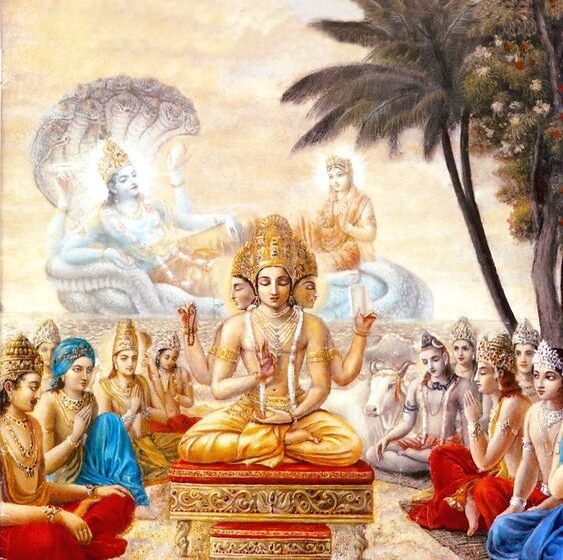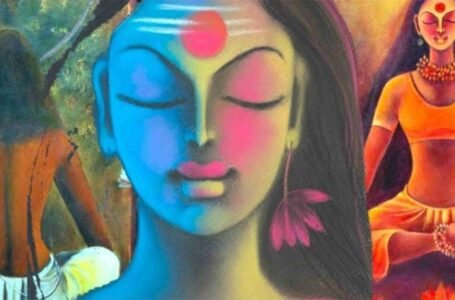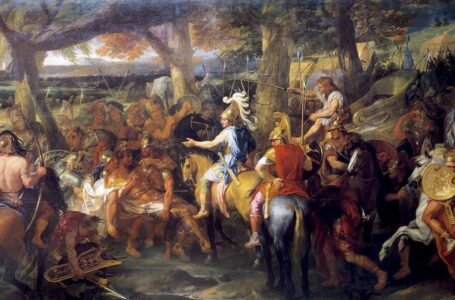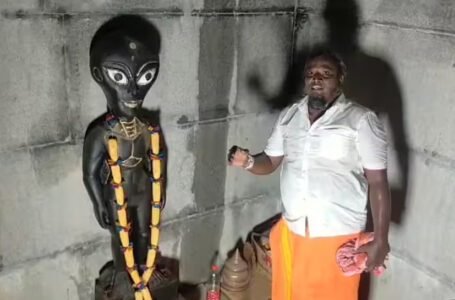Tracing Time and Cycles: Yugas and Ages in the Brahmanda Purana

The Brahmanda Purana is one of the eighteen Mahapuranas Its name, derived from the Sanskrit words “Brahma” (the creator god) and “Anda” (egg), reflects its focus on the creation of the universe, often symbolized by a cosmic egg. It is recognized as one of the most comprehensive Puranas in terms of scope and depth. It delves into a wide range of topics, from cosmology to mythology, religious rituals, and temple architecture. Although it primarily centres on creation and cosmic events, the Brahmanda Purana also provides invaluable insights into the social, political, and cultural contexts of its time.

History and Composition
Like most Puranas, the exact dating of the Brahmanda Purana is a subject of debate among scholars. generally, it comes down to the estimation of its composition between 300 CE and 500 CE, with subsequent additions over time. Most scholars agree that some sections, particularly the hymns and stotras, may have been composed even later. This reflects the layered composition of the text, with various sections added across centuries to keep the Purana relevant to evolving religious and social norms.
The Brahmanda Purana is composed of around 12,000 verses, divided into different sections known as Khandas. The text is divided into several distinct parts, including the Lalita Sahasranamam and the Adhyatma Ramayana which is an important section retelling the story of Lord Rama.

Mythology in Brahmanda Purana
One of the central themes of the Brahmanda Purana is its explanation of the universe’s creation, often symbolized through the metaphor of the “cosmic egg” or *Brahmanda*. This cosmic egg represents the primordial source from which the universe emerged; a concept central to Hindu cosmology.
The Concept of the Cosmic Egg
Brahmanda Purana begins with the story of the creation of the world. The first form of the universe was a golden egg which is said to have contained all of creation. From this cosmic egg, the creator god Brahma was born, and from him the entire universe took to existence. The idea of the cosmic egg is a recurring theme in Hindu mythology and also appears in other Indian texts such as the Rig Veda. The world enclosed within the egg symbolizes the interconnectedness of all living things and the cyclical nature of creation and destruction.

Ashta Vibhuti’s of Shiva
Brahma meditated for a son as renowned and powerful as himself and found a boy name Nilalohita on his lap. As the child cried so terribly as though he would burn himself with his radiance, Brahma asked him as to why was he crying so much the child asked Brahma to give him a name first and Brahma replied that the child would be named Rudra. The child continued to cry and when asked by Brahma as to why the child continued to cry, the latter asked Brahma to give a second name as Bhava. As this process of crying continued, Brahma gave the child further names as Sharva, Ishaana, Pashupati, Bhima, Ugra, and Maha Deva.

The child stopped crying but asked to be given the eight names as Nilalohita along with their inner meanings. Rudra is compared to Surya, whose brilliance is unparalleled. The second is called Bhava and has, as the body, the water. The third form of God is Sharva and its position is of the Bhumi whose great strength and power extends to the bones of Shiva, hence Bhumi is also called Sharva. Ishana is the fourth name of Nilalohita who is served by Vaayu or Wind.
Pashupati is the fifth Swarupa of Lord Shiva and his form and appearance are of Agni. Pashupati is said to be the preserver and the destroyer. The sixth name of shiva that had been mentioned is Bhīma and Ākāśa (Ether) is the sixth body of that name. The seventh is Ugra and the initiated Brahmana becomes the body of that name of. Maha deva, the eighth name, has the moon as the physical body. Therefore, the moon is Maha deva and the great lord is considered to be the Moon.

Worship
It describes different rituals, mantras, and offerings that should be made to please the gods. The Purana emphasizes that devotion bhakti is a crucial component of worship, and through proper rituals and sincere devotion, individuals can attain moksha.
Lalita Sahasranamam
The Lalita Sahasranamam plays a central role in the worship of the goddess Lalita, and chanting this hymn is believed to bestow immense spiritual benefits. It is which is a hymn that enumerates the thousand names of the goddess Lalita, a form of the Divine Mother. This hymn is central to the worship of the Goddess and is highly revered in the Shakti tradition. The Lalita Sahasranamam describes the goddess as the Supreme Being who embodies beauty, grace, and power. Each name in the hymn reflects a different aspect of her divinity, emphasizing her role as the universal mother who nurtures the cosmos.

Shri Radha Stotram
It is a hymn dedicated to Radha, the consort of Lord Krishna. Radha’s role as the beloved of Krishna is celebrated across Hinduism, particularly within the Bhakti movement, where her devotion to Krishna is seen as the epitome of love and surrender. The Shri Radha Stotram highlights Radha’s importance not only in the life of Krishna but also as a symbol of pure, selfless devotion.
Similarly, worship of Lord Vishnu and Shiva is prescribed in specific ways, with detailed guidelines for constructing altars, offering flowers, and performing sacred chants. The Purana also encourages observance of festivals dedicated to these deities, such as Navaratri for Goddess Lalita, and Ekadashi for Vishnu.

Scientific Aspects of the Brahmanda Purana
The Brahmanda Purana, although primarily a religious text, still contains conversations on scientific subjects, particularly in the fields of cosmology and geography. The Puranas give a detailed description of the universe, mention seven Dvipas or continents, and discuss various forms of existence.
Its description of the structure of the world, the cosmic egg, and the cycle of creation and destruction have been interpreted as examples of astronomical and cosmological processes. For example, the Cosmic Egg can be seen as an early attempt to understand the history of the universe, long before modern science’s Big Bang theory. The Purana also delves into time cycles, offering a division of time into vast periods known as Yugas.
Legacy
The Brahmanda Purana has had a lasting influence on Hindu thought, religion, and culture. Its contributions to Hindu cosmology, mythology and theology continue to influence devotees and scholars alike. The inclusion of Lalita Sahasranamam makes this Purana specifically dedicated to the worship of the divine mother, and the retelling of the Adhyatma Ramayana has important implications for the reading of the Ramayana epic.
The Brahmanda Purana has also contributed to shaping the cultural practices surrounding temple construction, religious rituals, and festivals. Its hymns and stotras are regularly chanted in temples and homes, serving as a source of spiritual inspiration and guidance.

Conclusion
The Brahmanda Purana remains one of the most important and widely known texts in the vast body of Hindu literature. Its study of the creation of the universe, its detailed cosmology and its rich mythology provide a deep understanding of Hindu thought. The Puranas’ emphasis on devotion, religious worship and the importance of the cosmic cycle reflect the Hindu view of God as interconnected with the individual’s macrocosm and microcosm of the whole entire universe.


